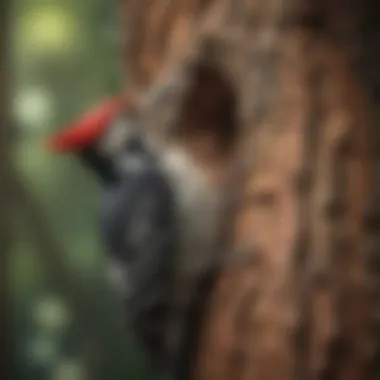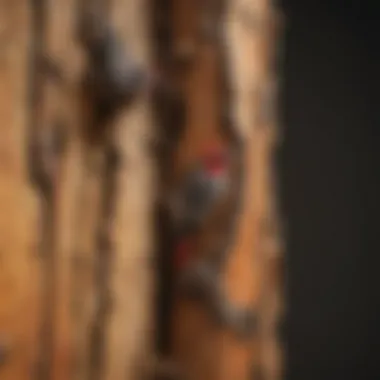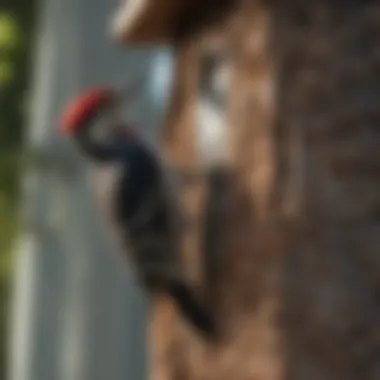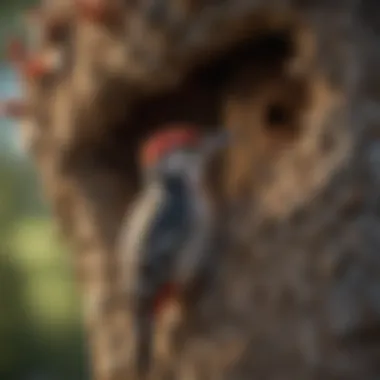Strategies to Deter Woodpeckers: Smart Solutions for Homes


Intro
Woodpeckers are fascinating birds but can become a nuisance for homeowners. These birds peck to communicate, find food, or make their nests. However, their behavior can lead to significant damage to your home. Understanding the nature of woodpeckers is the first step in finding effective strategies to deter them. Homeowners are increasingly seeking humane solutions that can protect their properties while respecting the wildlife around them. This article aims to provide insightful methods and techniques to address woodpecker issues.
Understanding Pests
Woodpeckers, like other wildlife, can be considered pests when their behavior leads to structural damage or disrupts the peace of a household. Distinguishing woodpeckers from other birds is crucial for effective management.
Definition of Pests
Pests are organisms that cause harm or concern in a specific environment. They can affect human activities or well-being. Woodpeckers become pests when their issues unfold in residential areas. They can peck at wooden surfaces, leading to holes and potentially harming the integrity of the structure.
Importance of Pest Identification
Identifying woodpeckers is essential for understanding their behavior. Knowing the species helps determine their habits and how best to manage their presence. There are several types of woodpeckers, each with distinct behaviors. For instance, the Downy Woodpecker is small and may prefer trees, while the Pileated Woodpecker is larger and often causes significant damage.
Prevention Techniques
Preventing woodpecker damage involves several practical measures. Understanding these techniques can empower homeowners to create a less inviting environment for these birds.
Home and Garden Preventative Measures
- Physical Barriers: Installing mesh or netting around vulnerable areas can deter woodpeckers. This method physically blocks their access.
- Reflective Surfaces: Using reflective tape or shiny objects can confuse and scare woodpeckers away. Hanging CD discs or metallic ribbons can be effective.
- Sound Deterrents: Woodpeckers are sensitive to sound. Playing recorded predator calls near infested areas can discourage them from returning.
Seasonal Prevention Tips
Awareness of seasonal behavior is essential. Woodpeckers may be more active during certain times of the year, especially spring when they seek nesting sites. Homeowners should take the following steps:
- Inspect property in early spring for signs of woodpecker activity.
- Repair any existing damage to wood surfaces, eliminating nesting opportunities.
- Regularly maintain the exterior of the home to limit inviting areas for these birds.
Eco-Friendly Pest Control Solutions
Homeowners increasingly prefer sustainable practices for managing pests. Eco-friendly solutions not only protect the environment but also manage woodpecker interactions effectively.
Overview of Sustainable Practices
Using humane methods aligns with the well-being of wildlife. Homeowners can adopt a few sustainable strategies:
- Refrain from harmful chemicals or poisons.
- Use natural barriers instead of lethal traps.
- Focus on habitat modification to make the area less appealing.
Natural Remedies and Their Effectiveness
Natural remedies can further support the cause. Here are some effective options:
- Essential Oils: Oils such as peppermint can act as deterrents. Spraying diluted oil on wooden surfaces may discourage pecking.
- Spices: Similar to essential oils, spices like cayenne pepper, when applied to wood, can deter woodpeckers due to their strong scent and taste.
Effective management of woodpecker interactions fosters a balanced relationship between wildlife and homeowners.
Understanding Woodpecker Behavior
Understanding woodpecker behavior is crucial for homeowners facing challenges with these birds. Woodpeckers are unique creatures, and their actions stem from specific needs and natural tendencies. Recognizing these elements allows homeowners to apply targeted strategies to deter them effectively while maintaining ecological balance.
The Natural Habitat of Woodpeckers
Woodpeckers enjoy habitats rich in trees, particularly forests and wooded areas. They thrive in places where they can find abundant food, such as insects hiding under the bark of trees. This preference often leads them to urban areas where suitable trees are present. Homeowners should observe their environment to understand how their property fits into the broader habitat woodpeckers seek. Knowing the natural habitat can help in recognizing which features of a home might attract these birds.
What Attracts Woodpeckers to Properties
Several factors draw woodpeckers to residential areas. By understanding these factors, homeowners can mitigate the likelihood of invasions.
Food Sources
Food plays a significant role in attracting woodpeckers. They primarily feed on insects found in trees, but they also enjoy suet and nuts available in residential bird feeders. Easing access to these food items can result in increased visits. More nutrients available in the area can transform a peaceful backyard into a woodpecker hot spot. Homeowners must be cautious about keeping such food sources well-managed.
Drumming Behavior


Woodpeckers are known for their drumming, a behavior that serves multiple purposes. This drumming is not just for finding food; it also establishes territory and attracts mates. When trees or homes have suitable surfaces, such as wooden siding, it may encourage woodpeckers to drum in those areas. Their drumming can be loud and damaging, so awareness of this behavior assists in addressing the issues early on.
Nesting Preferences
Nesting preferences further link woodpeckers to specific locations. They usually seek out trees with soft wood, which is easier for them to excavate for nesting. Structures with exposed wood may seem appealing as potential nesting sites. This preference highlights the necessity for homeowners to inspect their property regularly for vulnerabilities, which can attract nesting woodpeckers.
Understanding woodpecker behavior can provide essential insights for home protection strategies. Homeowners equipped with this knowledge are often able to form effective deterrence plans.
Types of Damage Caused by Woodpeckers
Understanding the types of damage caused by woodpeckers is crucial for homeowners. Recognizing the specific ways these birds can affect both natural environments and human structures allows for better prevention strategies. Damage from woodpeckers can lead to aesthetic concerns and serious structural issues, which may require costly repairs.
This section will detail the various aspects of damage associated with woodpecker activity, focusing on trees, shrubs, and home exteriors. This information equips homeowners with awareness to take proactive measures, safeguarding their properties from potential harm.
Damage to Trees and Shrubs
Woodpeckers often search for certain types of infestations in trees and shrubs. They may drill into trees to find insects and larvae. While this behavior is part of their natural feeding process, it can lead to bark damage. The wounds made by woodpeckers can create openings for pathogens, potentially harming the overall health of the tree or shrub. This is particularly concerning for ornamental trees in residential areas, where aesthetic value is essential.
Additionally, woodpecker activity can weaken the tree structure itself. If too much bark is removed, the tree can weaken to a point where it becomes unsafe. Homeowners should monitor their trees regularly and become familiar with signs of woodpecker activity. Using deterrent methods can help protect valuable landscape features.
Home Exterior and Structure Damage
Woodpeckers can inflict serious damage to homes, leading to expensive repairs. Their drumming behavior, which serves various purposes such as communication and territory establishment, often targets wood siding and shingles, among other materials.
Siding and Shingles
Siding and shingles represent a significant aspect of exterior home protection. Woodpecker drilling can compromise these features, leading to unwanted holes and openings. The unique characteristic of siding and shingles is that they provide both visual appeal and essential insulation. When woodpeckers attack these areas, it can result in broader damage, such as moisture infiltration and increased energy costs due to loss of insulation.
Additionally, siding materials vary widely in their resistance to woodpecker damage. Certain options like vinyl siding are more resilient compared to wood-based materials. Choosing the right siding type involves considering both aesthetic desires and functional capabilities against woodpecker attacks.
Window Frames and Eaves
Window frames and eaves are susceptible to woodpecker damage, often serving as prime targets for these birds. The specific aspect of window frames is that they play a critical role in energy efficiency, contributing to the comfort of indoor spaces. Woodpeckers can create holes that diminish energy efficiency and attract moisture issues.
Eaves support the roof structure and direct water runoff. Damage here can lead to significant structural integrity concerns. Homeowners should consider preventive measures such as installing physical barriers or deterrent devices. By addressing these vulnerable areas, property owners can maintain both beauty and functionality within their homes.
Impact on the Integrity of Property
The overall integrity of a property is at risk from woodpecker damage. Not only can structural security be compromised, but aesthetic appeal can diminish as well. This can affect property value and increase costs associated with repairs. Understanding these impacts can motivate homeowners to implement strategies to deter woodpeckers effectively. Education on the ways woodpeckers can cause damage serves as a foundation for informed action.
Ethical Considerations in Pest Management
When dealing with the presence of woodpeckers, it is essential to consider ethical aspects of pest management. This approach not only ensures compliance with local regulations governing wildlife but also aligns with growing societal values that prioritize humane treatment of animals. Understanding the specific needs and behaviors of woodpeckers can lead to more compassionate and effective deterrents.
The Importance of Humane Deterrents
Humane deterrents are pivotal in managing woodpecker interactions while minimizing harm. These methods do not inflict pain or suffering on the birds, an essential consideration for homeowners who may also appreciate wildlife. Notably, humane solutions include installing visual deterrents like reflective materials, which can confuse woodpeckers and discourage them from approaching.
Using decoys, such as predator models, can also be effective. They exploit the natural fear of woodpeckers while allowing the birds to thrive in their environment. This approach fosters a balance between pest management and respect for wildlife, which is increasingly seen as a responsible practice in modern society.
"Ethics in pest management reflects a growing awareness of our responsibilities towards wildlife and the environment."
Balancing Property Protection and Wildlife Conservation
Finding harmony between protecting one’s property and conserving wildlife involves careful consideration of both needs. Many homeowners face the challenge of safeguarding their homes against potential woodpecker damage without resorting to lethal measures. Effective strategies include maintaining proper landscaping and avoiding attracting woodpeckers to the yard.
Incorporating wildlife-friendly practices can improve the coexistence of homeowners and woodpeckers. For example, prioritizing natural deterrents like certain types of plants or barriers can protect property while limiting negative outcomes for the birds. Additionally, routine inspections of one's home can identify vulnerabilities, thus preempting woodpecker damage before it becomes a more significant concern.
Homeowners should advocate for balanced solutions that uphold wildlife conservation values. Engaging with local wildlife experts can provide insights into non-lethal methods tailored specifically for individual properties. By doing so, homeowners not only enhance their living spaces but also contribute to the broader scheme of wildlife preservation.
Effective Methods to Deter Woodpeckers
Detering woodpeckers is a pressing concern for homeowners. These birds can cause significant damage if left unchecked. Therefore, exploring effective methods becomes paramount. By implementing suitable strategies, homeowners can protect their properties. Understanding the methods available will help in choosing the right approach that balances effectiveness and ethics.
Visual Deterrents


Reflective Materials
Reflective materials are popular in detering woodpeckers due to their distinctive shine. These materials include items like aluminum foil, reflective tape, or even old CDs. The shiny surface captivates the attention of woodpeckers, leading them to avoid areas equipped with these deterrents. One key characteristic of reflective materials is their ability to create unexpected light flashes. This feature renders them effective in surprising the birds.
However, the effectiveness may vary based on placement and weather conditions. While they are generally easy to install, occasional maintenance is needed to ensure they maintain their shine. Homeowners should be aware that in some cases, reflective materials might lose effectiveness over time, necessitating replacements or adjustments.
Decoys
Decoys are another formidable visual deterrent. They mimic natural predators like owls or hawks. Installing lifelike decoys can trick woodpeckers into believing that danger is nearby, thus steering them away. A significant advantage of using decoys is their ease of setup and non-invasiveness.
Yet, it is important to move decoys occasionally. Birds can become accustomed to static objects. Thus, while decoys provide immediate benefits, their effectiveness can diminish if they remain in the same position for extended periods. Homeowners must remain vigilant and proactive in repositioning these items to sustain their deterrent effects.
Sound-Based Deterrents
Noise Makers
Noise makers like bells, wind chimes, or other loud devices can effectively dissuade woodpeckers. The repetitive sound creates an environment that feels hostile for birds, making it less inviting. The primary characteristic of noise makers is their ability to generate unpredictable sounds, keeping woodpeckers alert.
This method is advantageous due to its simplicity and accessibility. Homeowners can create their own sound setups using common materials. However, there's a balance to maintain. Continuous loud noise can become bothersome not just for woodpeckers but also for homeowners and neighbors. Thus, using noise makers intermittently is advisable to ensure they remain effective without causing disturbance.
Ultrasonic Devices
Ultrasonic devices emit high-frequency sounds inaudible to humans but distressing for birds. This technology represents a modern innovation in woodpecker deterrents. A key characteristic of ultrasonic devices is their ability to function discreetly without visible presence.
These devices have gained popularity for their effectiveness and convenience. They are easy to install, typically requiring minimal maintenance. However, their range can be limited, necessitating multiple units for larger areas. Additionally, some homeowners may be concerned about the effects on other local wildlife. Careful consideration is advised before general adoption.
Physical Barriers
Bird Netting
Bird netting serves as a physical barrier against woodpeckers. This mesh material effectively blocks access to trees, shrubs, or even certain building areas. One of its main advantages is the ability to offer a long-term solution. Bird netting is often durable and can be adapted to various structures on a property.
It is essential to ensure proper installation for the net to be effective. If installed incorrectly, it can be less effective and may even become a trap for other wildlife. Maintenance should also be regular to avoid wear and tear over time.
Wire Mesh
Wire mesh is another effective physical barrier. Its sturdy composition prevents woodpeckers from drilling into wooden surfaces. The characteristic of wire mesh is its strength, making it suitable for various applications, including protecting trees and vulnerable spots on buildings.
While it can be a highly effective deterrent, installation might require tools and some skill. Improper installation may risk damage to the surface it aims to protect. As with bird netting, it’s essential to regularly inspect and maintain wire mesh to ensure it continues to function optimally.
Preventive Measures for Homeowners
Preventive measures serve as the first line of defense for homeowners against woodpecker intrusion. Understanding and applying these strategies can prevent extensive damage before it occurs. A proactive approach minimizes the risk of woodpecker-related problems while also promoting a harmonious relationship between wildlife and property.
Maintaining Trees and Shrubs
Healthy trees and shrubs offer natural habitats for woodpeckers, but they can also attract them towards your home. Regular maintenance of these plants is vital. This involves:
- Pruning: Trim branches regularly to remove potential nesting sites, especially near the house.
- Removing Dead or Dying Trees: Such trees are appealing because they provide easy access to insects. Ensure that any decaying trees are taken down promptly.
- Fertilization and Watering: Keeping your trees healthy reduces the likelihood of pests that attract woodpeckers. Fertilization boosts growth while targeted watering prevents stress.
The focus should be on a landscape that is both appealing and less inviting to these birds, integrating beauty with functionality.
Secure Nesting Sites
Nesting preferences are critical to understanding woodpecker behavior. To discourage them from settling near your home, take measures such as:
- Installing Screens: Cover potential nesting holes in walls, eaves, and fences with durable screens or netting. This physical barrier can effectively stop woodpeckers from creating new nests.
- Using Deterrents: Visual deterrents can include shiny objects like old CDs, aluminum foil, or reflective tape. These can create an unwelcoming environment for the birds.
- Consider Alternative Nesting Structures: By offering designated birdhouses for other species, you may draw woodpeckers away from your home. Ensure these structures are placed at a reasonable distance from your property.
These precautions safeguard your property while still being mindful of the ecological dynamics at play.
Routine Property Inspections
Conducting routine inspections of your property helps in early identification of potential woodpecker issues. Focus on the following:
- Visual Check for Damage: Regularly inspect your home’s exterior for signs of woodpecker activity, such as pecking holes or damaged siding. Early detection can minimize repair costs.
- Evaluate Surroundings: Check trees and shrubs around your property. Look for dead branches or signs of infestation that could attract woodpeckers.
- Inspect for Nesting Evidence: During warmer months, pay attention to any irregular noises or movements from the eaves, as these could indicate nesting attempts.


Maintaining a consistent inspection regimen fosters an informed approach to property care, allowing for immediate responses to emerging issues.
"Prevention is always better than cure."
Implementing these preventive measures is essential in protecting your home from woodpecker damage. As a homeowner, taking the initiative not only preserves property value, but also contributes to maintaining the delicate balance between nature and urban life.
When to Seek Professional Help
When dealing with woodpeckers, homeowners may reach a point where their own efforts prove inadequate. Understanding when to seek professional help is crucial for maintaining a harmonious balance between personal property preservation and wildlife respect. Engaging professionals can offer unique insights and specialized solutions that may not be accessible through ordinary means. In this section, we will explore the signs indicating when it's time to consult a specialist and what benefits this can bring.
Identifying Severe Infestations
It is important to be aware of the signs of severe woodpecker infestations. Homeowners should monitor for continuous damage, especially when it extends beyond normal wear and tear. Here are some potential indicators:
- Repeated pecking sounds that persist over days and weeks.
- Large or multiple holes in siding, eaves, or trees.
- Visible nesting activity, such as debris or feathers.
- Damage that threatens the structure's integrity, such as rotting wood or compromised frameworks.
If any of these conditions arise, a professional may be necessary to assess the damage properly. The experience of specialists can lead to identifying the specific species involved, allowing for tailored strategies to manage them effectively. Addressing issues early can save homeowners from costly repairs down the line.
Consulting Wildlife Control Specialists
Consulting wildlife control specialists should not be viewed as a defeat but rather as a responsible approach to managing serious woodpecker interactions. Specialists can provide effective methods that align with both ethical wildlife management and homeowner needs. They possess the training to handle situations without employing harmful practices that could affect other wildlife.
The benefits of reaching out to a professional often include:
- Expert Assessment: They can evaluate the situation and recommend tailored solutions based on the species and extent of the problem.
- Safe Removal Methods: Experts know how to deter woodpeckers humanely and effectively.
- Long-Term Solutions: They may provide tips on how to modify property features to discourage future infestations.
Homeowners are encouraged to seek assistance when the methods they have tried are not yielding results or when they worry about the implications of woodpecker damage. Out of the various approaches available, a professional perspective can offer clarity and actionable solutions.
Examining the Role of Woodpeckers in the Ecosystem
Understanding the role of woodpeckers in the ecosystem is crucial for homeowners dealing with these birds. Many see woodpeckers solely as pests due to their destructiveness. However, they contribute significantly to ecological balance. They play vital roles in pest control and enhancing wood health. Their activities can have both direct and indirect benefits for both homes and the surrounding environment.
Benefits of Woodpeckers
Pest Control
Woodpeckers are natural pest control agents. They consume beetles, ants, and other insects that can infest trees and gardens. This reduction in pest populations helps maintain a balanced ecosystem. A key characteristic of this pest control is efficiency. Woodpeckers can digest insects hidden inside tree bark. This unique feature brings natural solutions to homeowners looking to control pest populations without chemicals.
While woodpeckers can help manage pests, it is vital to understand their feeding habits to minimize property damage. They may peck at trees to access insects, leading to potential harm. However, their overall contribution significantly outweighs this risk in many contexts.
Wood Health
Woodpeckers contribute positively to the health of wood in several environments, especially forests. By feeding on wood-boring insects, they help prevent infestations that could weaken trees. The characteristic of creating cavities can foster biodiversity as these holes become homes for other species, such as bats and small birds. This habitat creation makes woodpeckers beneficial for encouraging a richer ecosystem.
While encouraging wood health, their pecking can lead to some damage. Homeowners might experience knocks on their siding or eaves, which can lead to conflicts. The key is managing expectations and recognizing the importance of their role within the larger environmental context.
Understanding Woodpecker Species Diversity
Different species of woodpeckers inhabit various regions, adapting their behaviors and preferences. A broad understanding of these species can be beneficial for homeowners. It helps in identifying which birds might be causing problems and knowing their behaviors. Each type has unique characteristics that affect its interaction with the environment. By understanding these species better, homeowners can make educated decisions about how to manage their presence effectively.
Concluding Thoughts on Woodpecker Management
Woodpeckers, while integral to our ecosystem, can pose significant challenges for homeowners. The management of woodpecker interactions is not merely about preventing property damage but also about fostering a balance between human habitation and wildlife conservation. Understanding and addressing this relationship is crucial. It allows homeowners to protect their properties while ensuring that woodpeckers continue to fulfill their ecological roles.
Integrating Sustainable Practices
Sustainable practices in managing woodpecker populations are essential for long-term success. Homeowners should adopt strategies that do not cause harm to these birds but effectively deter them. Here are some practical approaches:
- Use of Non-Toxic Deterrents: Employ visual and auditory deterrents like reflective scare tape or noise makers that do not cause physical harm to woodpeckers.
- Habitat Modification: Keep trees and shrubs well-maintained, which reduces the likelihood of woodpeckers finding suitable nesting or feeding sites.
- Natural Barriers: Incorporate native plants that deter woodpeckers or physical structures that protect vulnerable parts of your property.
Integrating these sustainable methods also helps to promote a healthier environment. By choosing non-lethal options, homeowners contribute positively to local biodiversity.
Continuous Learning and Adaptation
Nature is dynamic, and so is wildlife behavior. Homeowners must engage in a continuous learning process regarding woodpecker management. Observing changes in woodpecker patterns, understanding seasonal behaviors, and adapting strategies accordingly are imperative. Some points for consideration include:
- Stay Informed: Keep up with the latest research or recommendations from wildlife experts and local extension services.
- Monitor Effectiveness: Regularly assess which methods are working and which are not. This is important to refine your approach and improve results.
- Engage with Resources: Utilize platforms like Wikipedia, Britannica, or even community forums on Reddit to share experiences and strategies with others facing similar issues.
By being proactive and adaptive, homeowners can effectively manage their properties while respecting woodpecker populations. This ongoing dialogue between human and wildlife behavior leads to solutions that are both effective and humane.
Understanding the balance between your home and nature is the essence of effective woodpecker management.



